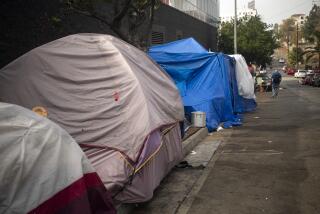Editorial: Accounting for L.A.’s homeless
On Tuesday evening, some 7,000 volunteers will embark upon a three-night effort to count the number of homeless people who live on streets, in tents and vehicles, or bed down in temporary shelters in Los Angeles County. The counters, under the supervision of officials from the Los Angeles Homeless Services Authority, plan to fan out across more than 95% of the census tracts in the county — the most territory the L.A. count has ever covered.
For more than a decade, this has been a biennial ritual. But this time, spurred by extra funding from the Veterans Administration and a sense that two years is too long to see if programs to house and help homeless people are actually working, the county only waited one year.
Of course, it’s essential to have up-to-date information on how many people are living on the streets. The 2015 count revealed that homelessness was up 12% from 2013. Of the 44,000 people found to be homeless, the majority were found to be “unsheltered.” The number of people living in tents and makeshift shelters increased a staggering 85% from 5,335 in 2013 to 9,535 in 2015. Seeing the new 2016 numbers and looking at the number of homeless people successfully housed last year provides the agency an idea of how effective policies have been and how many new people are falling into homelessness.
But such broad numbers are not enough. What’s also crucial is to understand who is living on the streets and how they got there. To this end, the homeless services agency conducts a separate demographic survey administered by trained outreach workers who are sent across the county over a six-week period to find and interview homeless people, asking them a barrage of questions about their backgrounds, how they lost their housing, how long they have been homeless, whether they have spent time in jail, whether they are military veterans, whether they have drug or mental health issues (and what kind), what their interactions with law enforcement have been. This year, surveyors aim to interview 4,500 people.
There’s an unusually acute sense of urgency surrounding homelessness right now. The increase in the 2015 figures and the highly visible presence of homeless people in every neighborhood have pushed city and county and state officials to scramble for more money, more plans, more promises. It’s not that they haven’t vowed to tackle this issue before in the past decade. They have, but they have not come near solving it. The information from this year’s count will offer them another tool to do so.
Follow the Opinion section on Twitter @latimesopinion and Facebook
More to Read
A cure for the common opinion
Get thought-provoking perspectives with our weekly newsletter.
You may occasionally receive promotional content from the Los Angeles Times.






